This is featured post 1 title
Replace these every slider sentences with your featured post descriptions.Go to Blogger edit html and find these sentences.Now replace these with your own descriptions.This theme is Bloggerized by Lasantha - Premiumbloggertemplates.com.

This is featured post 2 title
Replace these every slider sentences with your featured post descriptions.Go to Blogger edit html and find these sentences.Now replace these with your own descriptions.This theme is Bloggerized by Lasantha - Premiumbloggertemplates.com.

This is featured post 3 title
Replace these every slider sentences with your featured post descriptions.Go to Blogger edit html and find these sentences.Now replace these with your own descriptions.This theme is Bloggerized by Lasantha - Premiumbloggertemplates.com.

Tuesday, August 2, 2011
World Mysteries - The Bermuda Triangle

A large triangle-shaped area of the North Atlantic Ocean where unusual events are said to take place. The unusual events consist primarily of the disappearance of planes, ships, and people. The triangle's three corners are made up of (1) the island of Bermuda, (2) Miami, Florida, and (3) San Juan, Puerto Rico. The Bermuda Triangle is sometimes also known as the Devil's Triangle.
The first to report strange occurrences in the Triangle was Christopher Columbus. In his 1492 journey Christopher Columbus reported strange compass readings in the Bermuda Triangle. He and his crew then saw a mysterious light and a "flame of fire" in the sky.
The most famous Bermuda Triangle incident is "Flight 19." On December 5th, 1945, five U.S. Navy Avenger Torpedo Bombers were lost in the Triangle. The five aircraft left from Ft. Lauderdale, Florida, on a training mission. The flight was led by Lieutenant Charles Taylor. Early into the flight, Lieutenant Taylor's compass failed. A Florida native, Lieutenant Taylor tried to guide the planes home using only landmarks. The final words heard from Flight 19 were "Everything is wrong.....ocean doesn't look as it should". Did flight 19 simply get lost and crash into the Atlantic never to be seen again, or did something more mysterious happen?
On October 28th, 1943, the U.S.S. Eldridge is said by the U.S. Navy to have been located in the Bermuda Triangle. This is when the famous Philadelphia Experiment is said to have occurred. Was the U.S.S. Eldridge in the Triangle or in Philadelphia on that day - or was it in both places?
The Triangle itself may be an underwater UFO. Reports have been made of strange disc like objects hovering over the water in this area or plunging into the sea. It is believed that because of the types of engines they have, gravity drives or electro-magnetic powered, that they have adverse effects on equipment, explaining the strange compass readings.
Other people hypothesize that the Bermuda Triangle contains a high concentration of vortexes. These vortexes could be gateways transporting the lost planes and ships to other times and places. The unstable and temporary nature alleged in certain vortexes could account for their presence one moment, and disappearance the next.
The skeptics point out that the area of the Bermuda Triangle is quite large. There are strong currents and heavy traffic in the deep waters - some ships are bound to be lost. This may be true, but one certain region of the sea that has continued disappearances over the history of sea and air travel is a bit odd.
The first to report strange occurrences in the Triangle was Christopher Columbus. In his 1492 journey Christopher Columbus reported strange compass readings in the Bermuda Triangle. He and his crew then saw a mysterious light and a "flame of fire" in the sky.
The most famous Bermuda Triangle incident is "Flight 19." On December 5th, 1945, five U.S. Navy Avenger Torpedo Bombers were lost in the Triangle. The five aircraft left from Ft. Lauderdale, Florida, on a training mission. The flight was led by Lieutenant Charles Taylor. Early into the flight, Lieutenant Taylor's compass failed. A Florida native, Lieutenant Taylor tried to guide the planes home using only landmarks. The final words heard from Flight 19 were "Everything is wrong.....ocean doesn't look as it should". Did flight 19 simply get lost and crash into the Atlantic never to be seen again, or did something more mysterious happen?
On October 28th, 1943, the U.S.S. Eldridge is said by the U.S. Navy to have been located in the Bermuda Triangle. This is when the famous Philadelphia Experiment is said to have occurred. Was the U.S.S. Eldridge in the Triangle or in Philadelphia on that day - or was it in both places?
The Triangle itself may be an underwater UFO. Reports have been made of strange disc like objects hovering over the water in this area or plunging into the sea. It is believed that because of the types of engines they have, gravity drives or electro-magnetic powered, that they have adverse effects on equipment, explaining the strange compass readings.
Other people hypothesize that the Bermuda Triangle contains a high concentration of vortexes. These vortexes could be gateways transporting the lost planes and ships to other times and places. The unstable and temporary nature alleged in certain vortexes could account for their presence one moment, and disappearance the next.
The skeptics point out that the area of the Bermuda Triangle is quite large. There are strong currents and heavy traffic in the deep waters - some ships are bound to be lost. This may be true, but one certain region of the sea that has continued disappearances over the history of sea and air travel is a bit odd.
Test confirms Roswell debris is not from Earth
MCapri | Jul 12, 2011
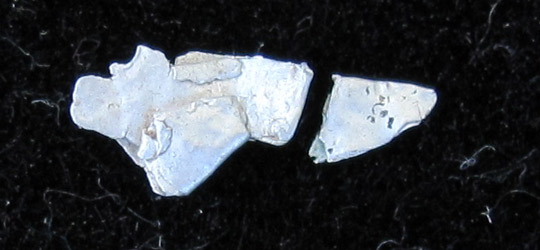
The artifact that has been analyzed. Specimen size about 10 mm long. End fragment clipped off for testing. (image credit: Frank Kimbler)
A teacher at the New Mexico Military Institute in Roswell may have discovered the first scientific evidence of manufactured debris made on another planet. Furthermore, this debris was found near the location where pieces from an alleged flying saucer were discovered outside of Roswell in 1947.
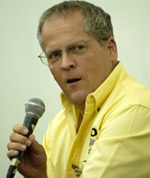
Frank Kimbler (image credit: Alejandro Rojas)
Frank Kimbler teaches high school level Earth Sciences and college level Geology at the New Mexico Military Institute in Roswell. He says he has always had an interest in UFOs, and actually had his own unusual sighting in his twenties. So when he moved to Roswell, he decided to put his expertise to the test and take a shot at investigating the most famous UFO incident of all time, the crash at Roswell.
He says his main goal was to find some physical evidence. He started by looking at some satellite imagery of the alleged “debris site.” This is where rancher, Mac Brazel, had told the Air Force he had found pieces of the crashed object. Kimbler used these images to enhance the infra-red in order to highlight areas where the ground was disturbed. He was surprised to find an area that was similar to what witnesses had described. It was about ¾ of a mile long and a few hundred feet wide, and facing the direction witnesses had reported. He also noticed this area had very straight edges, something unusual for a natural occurrence.
His next step was to get out there with a metal detector to see what he could find. He began making trips to the site in May 2010. Using a metal detector that could find a piece the size of a BB, three inches below the surface, he would be able to find small pieces, which was exactly his goal. In previous archeological digs in the area they had sifted dirt through screens with holes large enough for very small pieces to fall through. Kimbler figured that if there was anything left it would be very small and perhaps in animal burrows, or ant hills. An ant hill was actually where he found his first piece.
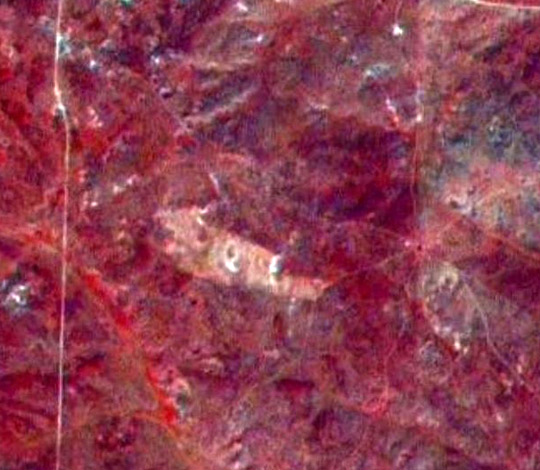
Landsat multi-spectral satellite image showing the debris field. The image clearly shows a burn (or disturbed area) covering the exact location of the debris field as described by witnesses. (image credit: Frank Kimbler)
What he found was a silvery metal that looked aluminum. This was strange because there were no indications of any sort of aluminum objects in the area. He occasionally found tin, which would come from parts of tin roofs blowing around, and some nails. He eventually found more of these silvery pieces, and says they looked shredded. Some of the edges even appear melted. He also found some aluminum buttons that appear to be the type used on military fatigues in the later 40’s. If that is the case it demonstrates that the military was in the area.

The buttons. Tentatively identified as military fatigue buttons late 40's early 50's. (image credit: Frank Kimbler)
Kimbler felt the small silvery pieces were interesting enough for further analysis. To get some help he went to theRoswell International UFO Museum and Research Center. Located in downtown Roswell, the museum is the main hub for Roswell UFO crash research. He showed the material to the museum’s director, Julie Shuster, and was able to meet with researcher Don Schmitt. They decided to fund the first test which was done by New Mexico Tech in Socorro. Using a micro-probe, they were able to determine the material’s composition. It turned out to be an aluminum, silicon, manganese, copper alloy. It is not unknown, but it is used in construction and not usually found in a foil form.
This further inspired Kimbler to get some isotope work done on the piece. Kimbler says the isotope work is so important because the ratios are “very much like our fingerprints.” Certain concentrations of elements on earth are unique to Earth. So if you know isotopic ratios for magnesium, it will be the same for anything on earth with magnesium, but if it is not from Earth, it will have a different ratio. For instance meteorites have different ratios because they are not from Earth. Isotopic analysis is necessary to determine if a material is from Earth or another world.
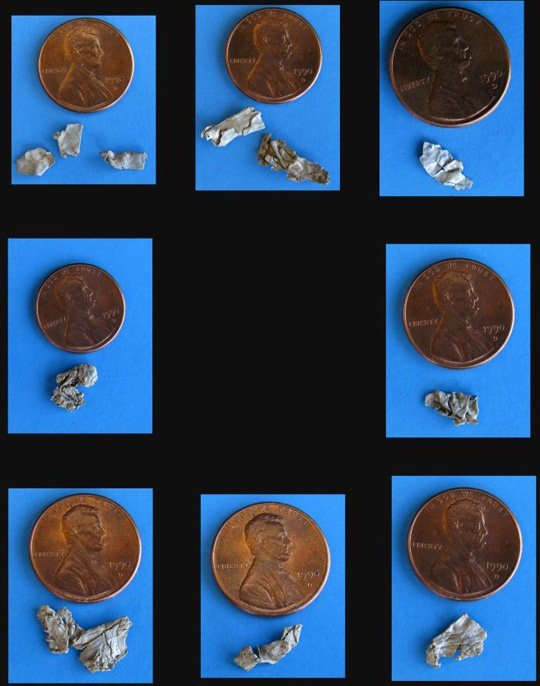
Some of the metal alloy fragments found buried and scattered over the debris field area. (image credit: Frank Kimbler)
Kimbler went to the University of New Mexico Institute of Meteoritics, and talked to their expert on isotopes to get an analysis done. Kimbler had not told the expert anything about the samples. He looked Kimbler “square in the eye” and told him that the only reason he would want to get this sort of test done is because he suspected the material was from outer space. He wanted to know where the material was from, and when Kimbler told him he refused to do the test, stating that the idea of a spaceship crashing at Roswell was “a bunch of hooey.” One of the other scientists in the office actually argued the point that if it is something unusual, the importance of that possibility makes it worth taking a look at. However, the expert didn’t budge and refused to do the work. The second scientist was a micro-probe specialist at the University and although he could not do any isotope work, he was able to get more specific information about the material’s composition and confirm the early work that had been done.
Bigelow Aerospace showed some interest in helping Kimbler with his analysis, but after spending months with little results, Kimbler had to go elsewhere. Kimbler was able to find another lab with multiple certifications willing to do the work. The UFO Museum put up the money, and the results were back in five days. Kimbler says he almost fell over when he saw the information. The ratios were off, and as he puts it there were only two answers to explain the results, “either the lab made an analytical error or the material is not from Earth.”
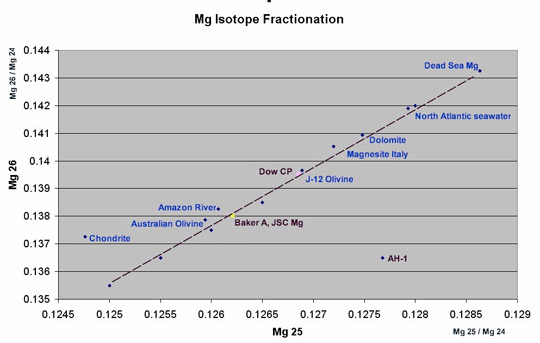
Magnesium isotope fractionation chart modified from the graph used by Dr. Peter Sturrock in his analysis of the Ubatuba UFO fragment. Magnesium bearing compounds, metals, and minerals should all plot on or very close to the line. A chondite is a type of meteorite and since it does not originate from Earth does not plot on the line. The Roswell AH-1 alloy plots way of the line. The AH-1 plot is an anomaly that is either an analytical error or the material is not from Earth. More testing is needed to verify the data to see if it is an error or its from another world. (image credit: Frank Kimbler)
However, Kimbler’s work is not finished. He says, “Following good scientific method protocol one set of data is not going to cut it.” In order to prove the lab did not make a mistake he needs to get more work done. He says he does have two more certified labs lined up to do more isotopic testing to confirm the work done thus far, and that he may have this work done within the next few weeks. Kimbler says in order to confirm the material is not from Earth, it is necessary to have two or three labs showing the same results.
Another important aspect of the material being aluminum and showing unearthly origins is that aluminum must be manufactured. Unlike some natural elements, such as gold or silver that can be found as nuggets in its raw form, aluminum is not found in nature. If this proves to be material not of this earth, it means this was something that was manufactured elsewhere. Thus far humans are not manufacturing anything in space, let alone something that would fall out of space and land outside of Roswell in a location where an alleged spacecraft was found in 1947.
Kimbler says he is being careful before making any definitive claims, but he is “hopeful.” He says certified labs don’t normally make mistakes, and that these people who did the work are some of the best in the business.
The implications if Kimbler’s material turns out to be of extraterrestrial origins and manufacture are of course startling. Could he have the smoking gun to prove we are being visited by an intelligent civilization from another planet, and that they crashed outside of Roswell in 1947? Kimbler says he will keep us up to date, and has been gracious enough to provide us with pictures of the material and the analysis.
Note: Most captions provided by Frank Kimbler.

New Mexico Tech microprobe data shows element composition of AH-1. Na and Cl values from small salt crystals embedded on the surface analysis shows AH-1 contains AL Si Mg Mn and Cu with small amounts of Fe. (image credit: Frank Kimbler)

University of New Mexico microprobe data shows element composition. Verified the NMT data with analysis showing AL Si Mg Mn Cu with a some Fe. (image credit: Frank Kimbler)
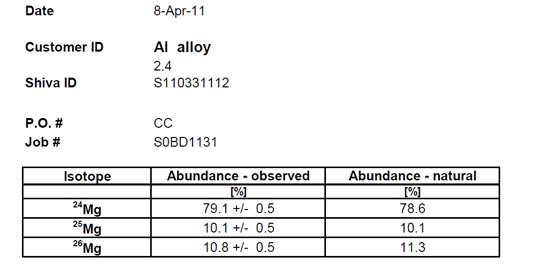
Magnesium isotope values from the certified lab that did the analysis. (image credit: Frank Kimbler)
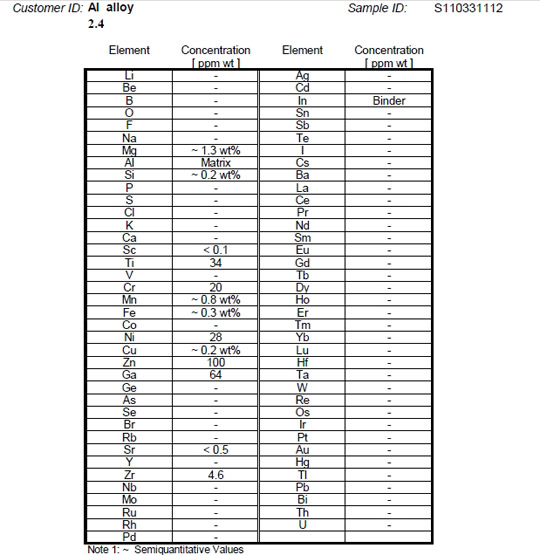
AH-1 alloy element composition from the same lab. Shows the AH-1 alloy is a AL-Mg-Mn-Si-Cu alloy. (image credit: Frank Kimbler)
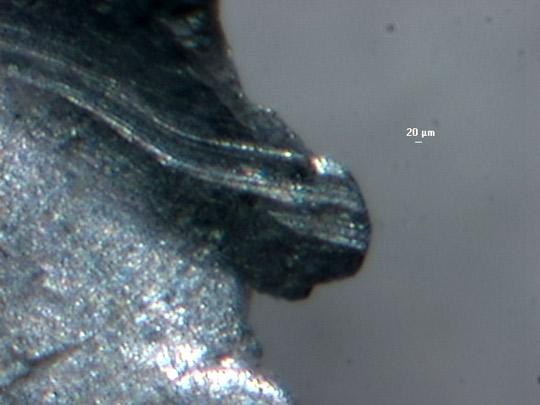
AH-1 under magnification shows banded or layered structures in AH-1. (image credit: Frank Kimbler)
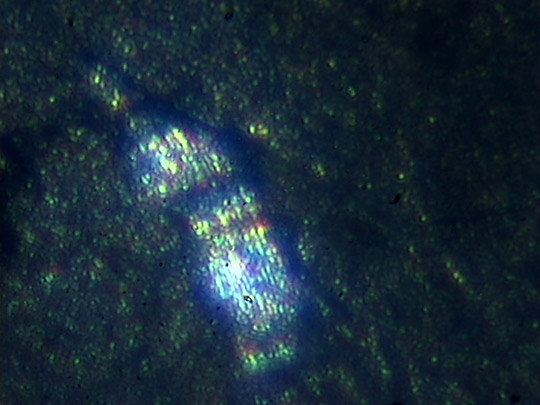
AH-1 under magnification shows more areas of banding. (image credit: Frank Kimbler)
Source
Alejandro Rojas
Dating site thinks it knows better than you
By MCapri
Source - Helen A.S. Popkin
Anyone who's been set up on a blind date with someone described as "perfect for you!" by a close friend or other sort of amateur matchmaker — only to spend an awkward couple of hours in the sixth through ninth circle of dating hell— will be instantly enraged to hear about the latest gimmick science of Match.com.
"Synapse," an algorithm project Match.com's been developing for the past two years, is designed to look past what you say you want in a potential mate, and suggest who you really want, the Financial Times reports:
So, if a woman says she doesn't want to date anyone older than 26, but often looks at profiles of thirty-somethings, Match will know she is in fact open to meeting older men. Synapse also uses "triangulation". That is, the algorithm looks at the behaviour of similar users and factors in that information, too.
It sounds a lot like those personality tests that ask you the same question 30 different ways to trick you into answering truthfully.
Sure, you don't need an algorithm to know that what people say is very often different from what they do, but the new math seems to be working for Match.com. While it's unknown how many actual dates Synapse helped orchestrate, users are interacting more with the top 5 date suggestions they're asked to rate daily, according to the site.
"Secret sauce" is how Nick Paumgarten of the New Yorker described the various exercises and algorithms online dating sites tout to attract hopeful singles to their services. "All these sites they all have an approach that they abide by," Paumgarten pointed out in an NPR interview about "Looking for Someone," his July expose on online dating services. "But the approach is also their — sort of their selling point."
Indeed, some of the dissatisfied Match.com customers called out by the Financial Times piece echo what you might hear on any dating site — be it eHarmony or OKCupid.
"The Match algorithm should have figured out that I don't want a 45-year-old from New Jersey," one thirty-something professional woman from Manhattan told the Financial Times. "Every time I log on I feel faintly insulted."
Computer officiates wedding, signals beginning of robot rule
By MCapri
Source - Helen A.S. Popkin
Any literate Luddite can write his own wedding vows — and not endanger the future of humankind. Instead, Miguel Hanson wrote his own minister.
Unable to get a friend to preside over Saturday's nuptials for him and fiance Diana Wesley, the Houston web developer and IT consultant went and coded a virtual minister named "Rev. Bit."

AP
Miguel Hanson, right, kisses his fiancee Diana Wesley by the computer that will soon rule us all.
"We're both friends of the computer. So it's kind of like our best friend is still marrying us,"Wesley told the Associated Press. "The computer is a huge part of our lives, so why not be a huge part of this?"
Wesley, 30, a high school sign language teacher, and Hanson, 33, met on theSweet on Geeks dating site — which seems about right. (Why, it's as if a computer wanted them to meet ... )
The couple claim to have a shared interest over science fiction and fantasy, yet there is no mention of cyberpunk, which could explain why they figured a computer minister is perfectly safe. "That's kind of our thing," Wesley said. "In fact, my maid of honor, she's making my cake and she's making it with Nerds as the topping and not icing. That's kind of the theme, the geeked out wedding."
(Eat cakes made of colorful candy while you can, Houston lovebirds. Soon, our robot overlords will have us toiling in servo factories.)
With a voice reminiscent of one Dr. Stephen Hawking, Rev. Bit presided over the ceremony via 30-inch monitor — square face with oval glasses on one side of the screen, purportedly executing words written by Wesley and Hanson on the other. He's a bit less animated than Japan's "I-Fairy" robot which married a couple last year. But what he lacks in movement, he makes up for in danger-distracting humor.
"If anyone here has anything to say that might change their minds or has any objections, they do not want to hear it and I will not recognize your objections since Miguel has programmed me to only recognize his commands," Rev. Bit quipped to the approximately 30 wedding guests in Hanson's parents' back yard.
Leaving no room for Clippy to offer, "It looks like you're getting married..." the couple spoke their parts, reading from a smartphones, of course. Hanson prompted Rev. Bit to speak his parts via a wireless mouse in his pocket.
More ceremony than legally binding, Rev. Bit doesn't have the credentials to officially marry the couple — yet. Until the machines take over, the lovebirds must also to go to a human justice of the peace and sign some papers for that.
Going in, the couple had complete support from their friends over Rev. Bit — though not all family members were into it at first. A couple members of the family were like, 'Really? A computer?'" Wesley said before the wedding. "I think once they see it. ... It's novel and so it's something they haven't seen."
Indeed. The video shows a glowing groom, a giggling bride standing before Rev. Bit's monitor — and your standard-issue teary-eyed guests — a must at any wedding. And who knows? Maybe all those wedding-presiding Elvis impersonators will be out of business as soon as someone programs that thing to sing.
Adorable? Sure, for now. But we all know how this ends.





 1:55 PM
1:55 PM
 Unknown
Unknown







